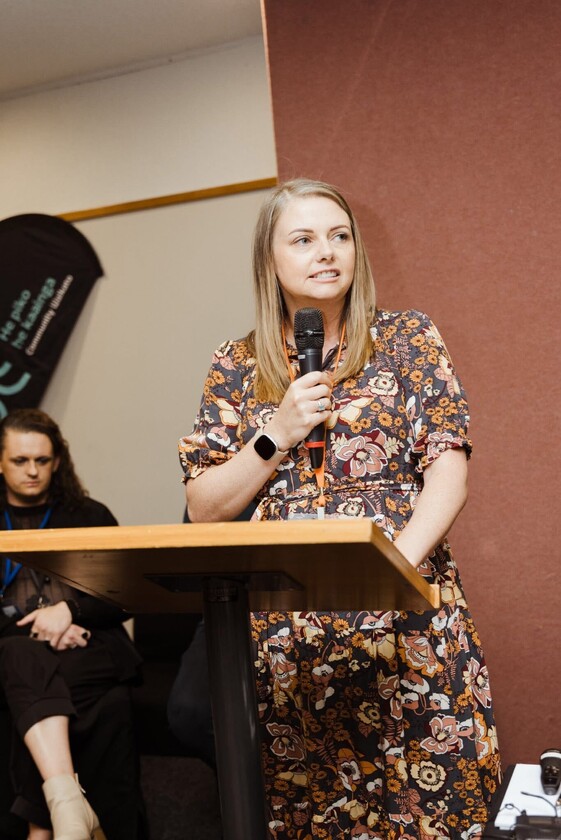This kōrero was delivered as part of a panel session at the 2025 Community Waikato Conference, themed Navigating the Tough Times: Connecting for a Sustainable Future. The panel brought together leaders from across the sector who are doing things differently – challenging norms, embracing creativity, and leading with care and courage in complex times.
I was invited to reflect on my own approach to leadership and share insights from my mahi that sits a little outside the ordinary. The session aimed to stretch our assumptions, encourage fresh thinking, and spark new possibilities for how we show up in community and in systems.
The kōrero below is my contribution.
_____________________________________________________________
Tēnā koutou katoa
I’ve been thinking a lot about what it means to see in this work.
Not the kind of seeing that sits in a vision statement or a strategic plan, but the more subtle kind. The kind that’s about really noticing what’s in front of us.
For a long time, many of us in philanthropy and community work were taught to see need … to look for problems and try to fix them. That came from a good place.
But over time I’ve realised that how we see matters just as much as what we see.
At the Len Reynolds Trust, we’ve been learning, very slowly, to see differently.
And like most good learning, it’s been a gradual unlearning too.
We used to think our job was to design good systems and make fair decisions.
But we started to notice that fairness, on its own, wasn’t enough.
Because Te Tiriti o Waitangi asks more of us than fairness.
It calls us into relationship: one based on reciprocity, respect, and shared responsibility.
So we began to ask different questions:
What would it mean to see through a Te Ao Māori lens: one that starts with whakapapa, with interconnectedness, with belonging?
What would it mean to move beyond consultation to genuine partnership, where the relationship itself is the kaupapa?
That shift has changed everything for us.
It’s taken us down a path that’s slower and less tidy, but far more human.
And the more we sit in that space, the more we realise that our best work doesn’t come from control, it comes from connection.
We haven’t nailed that balance. Most days it feels like walking a line between wanting to be bold and needing to be careful, between courage and caution.
But I think many of us live in that same tension. We want to do things differently, while still keeping things steady enough for others to rely on us.
One mindset that helps me stay grounded is remembering that it’s okay not to have all the answers.
Leadership in this work, especially work that honours Te Tiriti, isn’t about certainty. It’s about being willing to learn in public, and to be changed by what we learn.
Some of the most meaningful shifts for us have come through small acts of trust: sitting with a community partner over cups of tea instead of emails, or admitting when we don’t know the next step and asking, “What do you think?” And then listening to the answer. Truly listening.
And it’s in those moments that I’ve seen collaboration, care, and creativity come alive, as lived values that have always been at the heart of Te Ao Māori.
One of the most important relationships for us has been with Ngāti Wairere: the hapū whose whenua seeded our trust fund. That relationship has challenged and grounded us in equal measure, teaching us about whakapapa, about time, and about responsibility.
It’s reminded us that Te Tiriti isn’t a historical document to be referenced - it’s a living relationship to be practised.
And it’s made me think that maybe what’s emerging - what’s visible but not yet widely seen - is a different kind of philanthropy altogether.
One that’s less about giving, and more about honouring.
Less about impact, and more about integrity.
Less about charity, and more about whakawhanaungatanga -about being part of something larger than ourselves.
When I look around the sector, I see glimpses of this everywhere - funders sitting in hui with community instead of in boardrooms, community organisations leading design, people slowing down enough to build real understanding.
It feels like something is shifting.
But it’s subtle. It doesn’t always show up in reports or dashboards, and dare I say it, outputs.
It shows up in who’s at the table. In what voices are centred. In who we listen to when it’s inconvenient.
So if I had to answer the question: “What is it you see, that may not yet be seen by others?”, I think I’d say this:
I see a sector beginning to decolonise its gaze. Beginning to understand that our role is not to give, but to uphold; not to tell, but to listen.
I see philanthropy beginning to trust itself enough to let go of control, and to be guided by the values that have always sustained this land: manaakitanga, kotahitanga, whakapapa.
And that, to me, is something worth holding onto.
Because if we can keep seeing through that lens - with generosity, humility, and courage - then I believe we can navigate these tough times with exactly what this conference calls for: collaboration, care, and creativity.
Tēnā koutou, tēnā koutou, tēnā tātou katoa.
_____________________________________________________________
This kōrero was prepared and delivered by Melissa Gibson for the Community Waikato Conference on 12 November 2025. If you wish to share or reference any part of it, please attribute it appropriately. It’s not for reproduction without permission.
Ngā mihi.
